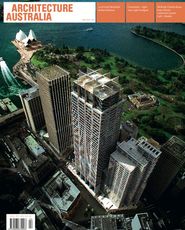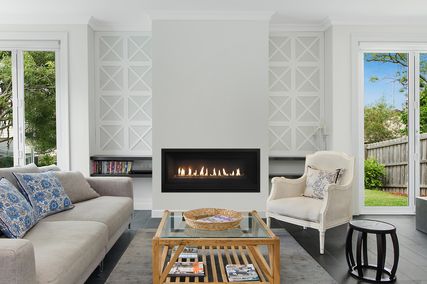Sophisticated survey, visceral pleasure. Kerstin Thompson outlines plans for the Australian Pavilion at Venice this year.
The Venice Biennale is a fast, exuberant festival of architecture. Regardless of the theme ultimately selected (unknown as we write), whether serious or whimsical, we intend to joyfully and forcefully express a sense of Australia as an abundantly creative laboratory for architecture.¹ In exhibiting architecture, there is a risk of solemnity. We wish to communicate the considerable weight of this country’s architectural intelligence within a pleasurable and visceral atmosphere. Our creative direction is founded on a generosity of spirit, one that is engaging and inclusive.
Increasing the range of work exhibited is critical to our approach. We will do this in two ways. First, we will include a range of emerging and established practices to demonstrate the divergent approaches to generating buildings here and now. The second range is historical. This will provide the context for the current works and will situate some of today’s strands of thinking within the canon of Australian architecture. The 2006 exhibition by Shane Murray and Nigel Bertram emphasized the physical context of a handful of recent buildings; the 2008 exhibition will emphasize the historic context of current production.
Providing a historic grounding is important for several reasons. It recognizes that our architectural production is richer than is often able to be represented when the country’s output is compressed into a handful of practices. It invites us to consider and celebrate the conditions here that somehow foster an array of positions and dialects, and which can only partly be accounted for by geography.
But, perhaps most importantly, the historic context is essential to our mission to transform the view of Australia as a nation without history, to dispel the myth that we are a young nation with a tenuous grasp on culture, whether architectural or other. In combining the digital past with the analog future, we seek to present an architectural culture, not just a series of unrelated and incidental events – a multi-headed and cross-generational conversation that is rich and provocative. The scope and breadth of current production is precocious – its abundance belies the youth of our built history. Our team wants to showcase this culture of Australian architecture.
Exploiting the bipolar format of Philip Cox’s pavilion, we envisage a two-part exhibition. The first part will offer a digital journey through our architectural past made up of still and moving images. Imagined as a fast ride looking backwards, it will immerse visitors in a glittering and luminous sea of our built legacy. This is a primer for looking forwards to our analog future, which will be rendered in the second part, by contrast, as a wild and overgrown garden of 150-plus models.
Let a hundred flowers bloom.
Let a hundred schools of thought contend.
The split into digital past and analog future does not preclude multiple threads binding these apparent opposites. In curating past and possible architectures, we will make some of these lineages explicit, exposing various architectural families and relatives, emphasizing cross-generational exchange and conversation – the mad cousins, the errant daughter, the local patriarch and the strays who resist aligning themselves with any particular group or tradition.
We choose to err on the side of excess, preferring exuberance to restraint, wilfulness to caution, impressions to conclusions. Partly this is in the tradition of irreverence, and hints at the extent to which we exploit our situation to have a crack at it, whatever the experiment may be. The sheer number of voices we intend to include is anti-authoritarian, democratic and decidedly loose. Our curatorial aim is to open up rather than narrow the field. In gathering so many flowers we invite visitors to make their own connections as they journey through our field of dreams, possibilities and potentials.
Our focus on the model for the rendering of the next generation of buildings will emphasize the material beginnings of ideas. Not only do models intimate the working methods of the architects, as a collection they will also create a rich spatial experience, giving visitors the opportunity to inhabit a world of miniature architecture. The exhibition will exploit the pleasure of the artefact. Thus we intend to marry a sophisticated historical survey with the visceral pleasure of architecture. An exhibition that will be legible on many levels – cerebral and corporeal, expert and layperson, slow and fast – seems an appropriate antidote to biennale exhaustion. If this is the twentieth pavilion visited towards the end of a hot and steamy autumn afternoon in Venice, then a speedy trip through Australia’s architecture, which finishes with the invitation to lounge in a hammock, seems about right.
Of course our primary goal is to show off our precocious culture of architecture. Part of this entails creating a space for exchange and discussion and establishing a distribution point from which to gather mementos that can be circulated within the world at large. So the Abundant team’s vision extends to collateral such as T-shirts, bags, posters and books. Through these we will populate Venice and beyond with an indelible memory of Australian architecture as provocative, beautiful, ugly, sophisticated, restrained, unruly, original, referential. Eclectic.
Kerstin Thompson is a member of Abundant, Creative Directors of the Australian Pavilion at the 2008 Venice Architecture Biennale. Team members are: Neil Durbach, Vince Frost, Wendy Lewin, Kerstin Thompson and Gary Warner.
¹ It has since been announced that Aaron Betsky is the director of the 2008 Venice Architecture Biennale, with the theme Out There. Architecture Beyond Building.















